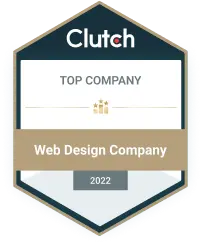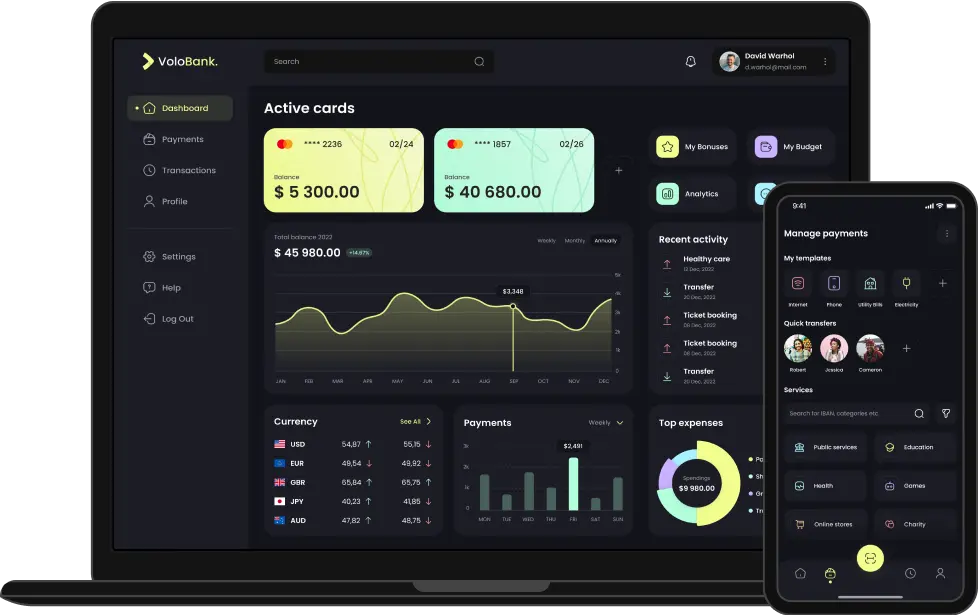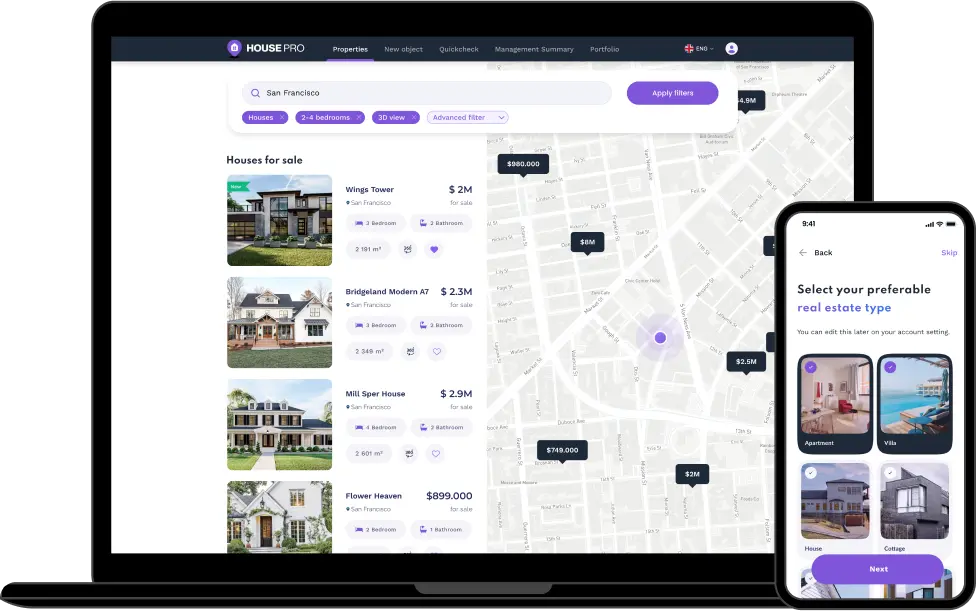Our web design services
Custom website design
Our design specialists have in-depth expertise in designing web applications for various purposes. We ensure close collaboration with the clients to understand the requirements of the project and deliver a result on time and within budget.
- Platform design
- E-commerce design
- SaaS app design

Web application design
We provide full-cycle mobile app development services, becoming a trusted partner from the discovery phase all the way to development and launch. Limeup allocates the best software developers that specialize in the latest application technologies to create a solution that caters to your expectations.
- Native and cross-platform development
- iOS and Android applications
- UI/UX design & branding

Website redesign
We offer comprehensive web designer services, including slight tweaks to the design that will improve operations, as well as a complete design revamp that will take your brand to the next level. Contact us to get started with your project.
- Reinvented branding
- Conversion rate optimization
- Complete design overhaul

Our process for custom web design services
The starting point of our collaboration is diving into market and competitor research to understand the current trends and demands in a given industry. Our web design service includes applying different research methods to analyze the pains and needs of the target audience. After conducting user interviews, surveying, and other analyses, we compile a comprehensive plan for the future design.

Our design experts use research findings to work on creating the website structure by designing wireframes and prototypes that will serve as an initial foundation for the design. The goal is to verify if your target audience can easily navigate through the website and carry out basic tasks. Once this stage is approved, we move on to the next web designing services.

Communicating closely with our clients, we put effort into strategic branding and establishing a brand identity for the business. Our team of experienced specialists in this sector formulate the overall vision of the brand, as well as its voice, ensuring the message is clear and compelling. We also set up branding guidelines that detail the use of color schemes, logos, typography, and more.

Limeup’s website design service entails building a pixel-perfect interface design for your web solution. We adhere to the branding guidelines when designing your web platform or an application, ensuring your feedback is implemented at every step of the process. Our design experts also make certain that the experience is impeccable and engaging for users.

As a provider of web designer services, we offer on-demand web development support to help you implement our design solutions correctly and successfully. If you don’t have developers in-house, our team of middle and senior specialists will be ready to develop a website for you.

Book a free call with an expert


Why work with us
FAQ
How much do website design services cost?
The cost of a website design service can vary greatly depending on several factors. While we can’t estimate the exact price without consultation, here are some of the influential aspects to keep in mind:
- The complexity of the project. A simple website with a few landing pages is going to cost less than, for example, a complex corporate website with a lot of custom features.
- Timeline. If clients set strict and short deadlines, it is going to cost more since specialists would require more resources to complete the project on time.
- The experience level of the team. It is inevitable that the services of mid and senior-level designers will be more costly since clients pay for their expertise.
- The number of team members involved. Depending on how complex your ideas are to bring to life, the service provider might need to onboard more members on the team, which could increase the final cost.
- Levels of customization. If you’re looking for a highly customized design that would require specific features tailored to your business, it will cost more, as opposed to using pre-made templates and layouts.
On average, providers charge per hour for their services. Junior designers may cost around £20 — £40 per hour, while the services of mid-level to senior designers can cost anywhere between £40 — £120+ an hour.
How long does a web design service take to complete?
The time it takes to complete a web design service will depend on its complexity and the scope of work. It will also vary depending on the deadlines you set, the workload of specialists who build websites, and if you require any additional support down the line.
Generally, simple designs with basic features and a smaller amount of landing pages may take several weeks to complete. While highly customized web designs can take up to several months to deliver the final result.
Do you offer SEO-friendly web design services?
Search engine optimization, or SEO, in web design is the practice of designing a web platform that operates according to the requirements of search engines. Optimizing your website to rank higher in engines like Google is important, as this is the way to get organic traffic to the site.
Creating a stunning interface and user experience for your website is not enough if users can’t organically find it through search algorithms. Therefore, our web designer services include SEO-friendly practices that are aimed at making your web platform perform well. In particular:
- Readability. Using high-intent keywords and meaningful copy on your website increases the content value, both in the eyes of search engines and users.
- Sitemaps. A sitemap is a file that compiles all the pages and media on your website, which helps search engines crawl them and understand the content of the site in order to rank it appropriately.
- Alt tags. Alt tags are textual descriptions of media files that are on your website, which also increase the accessibility of your platform.
- Metadata. Such data includes title tags and a meta description of your web pages that is visible in search engine results pages.
What are the advantages of choosing web designing services in the UK?
For a business based in the United Kingdom, there are many major benefits of partnering with professional web design services organizations in the UK. Luckily, there are thousands of potential candidates that could make a good partner for your brand, so choosing the right one won’t become an obstructing issue. Let’s go over a few key advantages of choosing a UK-based company that specializes in web design.
#1 Understanding of the local market
Collaborating with a company from the United Kingdom is going to eliminate the issue of a design provider not understanding the market they are making a web design for. UK companies have experience and expertise in cultural settings and customer preferences, making it easier to cater to a particular market.
Local custom web design service providers will also have a more in-depth understanding of the imagery and language that tends to appeal more to the target audience. This will increase the chances of the product being successful and competitive in the market.
#2 Time zones and face-to-face communication
Time zones become a problem when design specialists are not available to answer questions from the client, ultimately obstructing and delaying the operations. Local website design vendors typically do not run into such an issue. Another big advantage of working with a United Kingdom-based design agency is the ability to have face-to-face meetings.
Although the ability to arrange video conferences and meet-ups has become normalized over recent years, some clients still prefer natural communication. Additionally, local collaboration can make for more accessible ongoing support and maintenance in case you run into any issues after the launch. Having a provider in your time zone will ensure a faster problem resolution.
#3 Compliance with the local regulations
One often overlooked advantage of partnering with UK providers is their ability to meet legal requirements and regulations. A UK-based web design provider has a more cohesive grasp of safety policies and data protection laws, such as the General Data Protection Regulation (GDPR).
A local company will provide insights and guidance when it comes to data security, enabling you to conduct operations with a peaceful mind. Overall, choosing web designing services in the UK can present you with more possibilities and positive impacts on your brand and reputation.
How do you ensure my requirements will be met?
Many clients worry about their requirements being understood and adhered to by web designer service vendors. It is a completely rational fear, so our design experts at Limeup put effort into dispelling any anxieties.
We work closely with our partners, ensuring transparent and frequent communication. Our designers prioritize feedback and implement any updates according to the request of the client. We believe in a customer-centric approach and respect the wishes of our patrons so that the collaboration process is smooth and enjoyable, leaving a positive experience after the partnership ends.
What to consider when choosing a website design services provider?
Before you can choose a web design vendor to collaborate with, it’s important to evaluate a few key factors that will come into play during the design process. You should take your time to ensure you pick a partner that best meets your needs and will provide a top-notch web designing service. Let’s talk about several moments that you should consider before signing a contract with a company.
#1 Portfolio of previous works
To evaluate the experience and expertise level of potential candidates, you must review their portfolios. You can make your assessment more structured by asking yourself the following questions:
- What kind of industries do they have experience creating a design for? For example, e-commerce, healthcare, fintech, igaming, etc.
- Do they have previous experience working in your specific industry?
- What was the duration of their previous collaborations?
- Has the collaboration positively impacted the business of a client?
- Does the organization offer ongoing support services?
Creating an organized spreadsheet with similar information can help you keep better track of the designers you review. It is also a good idea to check out case studies on the website to get more detailed info about the project and collaboration process.
#2 Web design skills
You must assess what kind of skills the designer possesses in order to see if they can help you bring your ideas to life. Ideally, the designer should be skilled in UI and UX design to provide a comprehensive web designer service. Here are some of the necessary skills that will be required to create an excellent design:
- Understanding the principles of mobile-friendly design and web accessibility standards.
- Responsive and SEO-friendly design.
- User journey mapping.
- Conversion Rate Optimization (CRO).
- HTML and CSS knowledge.
- Wireframing and prototyping.
- Branding, color theory, and typography.
- Coding basics.
#3 Communication and collaboration skills
The soft skills of a design provider are no less important than their hard skills when it comes to establishing a seamless design process. You will most likely be able to evaluate the communication skills of the experts through an interview where you can ask questions about what their collaboration style typically looks like.
A good designer must be able to translate concepts and ideas to clients in a clear and understandable manner. You can also ask situational questions to see how they would handle challenging situations and what their problem-solving approach is.
#4 Design tools and software
An experienced designer uses a variety of tools in the work cycle. It’s best to make sure the candidate is knowledgeable about which tools help create a functional and appealing web design, as well as being proficient in using them.
If it’s not mentioned in any descriptions on the company’s website, you can ask the web designing service providers during an interview about the types of software they use in their work. Most commonly, designers are skilled in tools like Adobe XD, InVision, and Figma.
#5 Testimonials from former clients
Testimonials and reviews from previous clients can tell a lot more about a candidate than a resume or portfolio. It’s a good idea to contact their former partners for a recommendation. You can also ask for some details of their collaboration that don’t disclose confidential business details, for example:
- What was the communication like? Did the exports showcase professionalism and responsiveness when collaborating with the team?
- Was the client satisfied with the end result of the collaboration? Did the final result deliver and meet all of the expectations from the service?
- Have any issues come up during the partnership? If so, how did the design team resolve and respond to negative feedback?
- What was the impact of the work? Have they witnessed positive results from the web design service?
- Would they recommend working with the designer? Any particular qualities that stood out, such as creativity, ability to meet deadlines, etc?
The answers to these questions can help you build out a less biased idea about a particular provider. Formulating your requirements clearly is also a cornerstone of successful collaboration, so keep that in mind when searching for the most suitable candidate.
Create your product with us

Account Executive

Business Development Manager
What to Look For in a Software Development Services Provider?
Filtering out dozens, if not hundreds, of potential candidates for software development is burdensome if you lack knowledge about defining factors. While many of the contenders are qualified and competitive, some of their characteristics require careful consideration. Here is what you need to pay extra attention to.
Proven track record of work.
Before contacting a particular software development services provider, you need to make sure they have a proven track record of developing software. This can be done by checking out their website and seeing if they feature any case studies.
These are documented descriptions of projects they have previously worked on, which detail the requirements and the scope of work. The best case scenario is finding cases that are similar to your project idea. That way, you can be more assured they are capable of carrying out the idea by comprehensively understanding the nuances of the software project.

Appropriate expertise and experience.
Since software development covers a great variety of services, it is important to find an organization that specializes in the technologies that your project requires. You can check out a “Services” page on the company’s website and research what kind of professional offerings are listed there.
If you decide to contact a particular vendor, you should ask about the level of experience of the team members who will be onboarded to the project. While more simple projects can be handed to less experienced designers and developers, complex software within nuanced industries is better suited for middle and senior-level specialists.
Positive reviews and testimonials.
Word-of-mouth is a tried-and-true method of finding trustworthy and competent candidates. Receiving references from former clients is a way to get to know the company’s process from an insider perspective. So you can ask your colleagues with which vendors they have collaborated in the past and if they would recommend the partnership.
On top of getting personal recommendations, checking out online reviews is also a must. Because you may not necessarily find colleagues willing to share their experiences. Evaluating testimonials on review websites helps you understand what kind of software development solution was built and how the client rated the collaboration process.

Clear budget policies.
This factor will most likely be revealed during your initial consultation with a development provider. Getting a transparent and straightforward breakdown of the cost of the services is essential to building a reliable relationship between the client and vendor. Not to mention, it helps minimize risks of budget constraints when the development begins.
Ask for a direct quote on your project considering all of its requirements, as well as taking into account any unforeseen changes. At this point, you will also agree on the pricing model, which can be on a per-hour basis or a fixed price for the amount of work.
Post-launch support and maintenance.
It is advised to hand over the ongoing technical support and maintenance efforts to a development team that worked on creating the original software development solutions. While it’s not uncommon to seek out other providers for long-term support, having a team that knows the software inside out can be more advantageous.
Therefore, the ideal option is to find a development company that offers support services, like server monitoring, certificate and library updates, etc. Be sure not to neglect maintenance, as it becomes one of the main instruments of keeping your software operational.











I am impressed by Limeup’s team approach to providing quality website design services. They took their time to understand our objectives and target audience. Their designs are clean, intuitive, and visually appealing, which helped us create a banking app that a wide range of users could adopt.